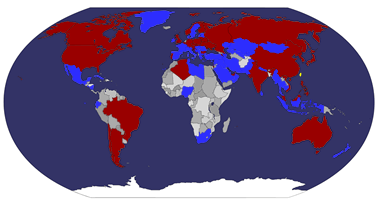The 60th Anniversary of Enforcement of the Local Autonomy Law - Saga Prefecture/
Le 60ème Anniversaire de Mise en vigueur de la Loi d'Autonomie Locale - la Préfecture de saga
Saga Prefecture (佐賀県 Saga-ken) is located in the northwest part of the island of Kyūshū, Japan. It touches both the Sea of Japan and the Ariake Sea. The western part of the prefecture is a region famous for producing ceramics and porcelain, particularly the towns of Karatsu, Imari, and Arita. The capital is the city of Saga.
In ancient times the area composed by Nagasaki Prefecture and Saga Prefecture was called Hizen Province. The current name dates from the Meiji Restoration. Rice farming culture has prospered here since ancient times, and vestiges can be seen at the ruins of Nabatake in Karatsu and the Yoshinogari site in Yoshinogari.
From the Kamakura period to the Muromachi period it is thought that over 100 feudal clans existed. Also exerting great influence during this time was a samurai clan operating along the Genkai Sea called the Matsuratō. Upon entering the Sengoku period, the Ryūzōji clan expanded their control to include all of Hizen and Chikugo Provinces, and part of Higo and Chikuzen Provinces. After the death of daimyo Takanobu Ryūzōji, Naoshige Nabeshima took control of the political situation, and by 1607 all of the Ryūzōji clan's domain was under the control of the Nabeshima clan.
In the Edo period this area was called the Saga Domain (佐賀藩 Saga-han), and it included three sub-domains: the Hasunoike, Ogi and Kashima Domains. Also within the current borders of Saga Prefecture during this time were the Karatsu Domain (唐津藩 Karatsu-han) and two territories of the Tsushima-Fuchū Domain (対馬府中藩 Tsushimafuchū-han). Saga Domain and its sub-domains continued to be ruled by the Nabeshima clan, its various illegitimate family lineages and members of the former Ryūzōji clan, and politically the area was relatively stable. However, the cost of defending Nagasaki was increasing and, difficult from the start, the financial situation was worsened by the great Kyōhō famine and the Siebold Typhoon of 1828. Nevertheless, due to the large area of reclaimed land from the Ariake Sea arable land was able to increase significantly and by the 1840s the annual koku of Saga Domain increased to about 670,000, twice that of 200 years before.
Around the middle of the 19th century, Naomasa Nabeshima strove to set right the domain's financial affairs, reduce the number of government officials, and encourage local industry such as Arita porcelain, green tea, and coal. Also, thanks to the proximity of the international port of Nagasaki, new technologies were introduced from overseas, such as the reverberatory furnace and models of steam locomotives.
After the Boshin war, many people from Saga Domain assisted in the Meiji Restoration. In the Meiji era the modernization of coal mines in Kishima and Higashimatsuura districts, among others, progressed bolstered by the construction of railroads.
La préfecture de Saga (佐賀県, Saga-ken) est située dans la partie nord-ouest de Kyūshū, au Japon. Elle est entourée par la préfecture de Fukuoka à l'est, la préfecture de Nagasaki à l'ouest, la mer de Genkai au nord, et la mer d'Ariake au sud, où la différence entre la marée-haute et la marée-basse est d'environ six mètres.
Avant 1871 et la mise en place du système des préfectures, la région composée par la préfecture de Saga et la préfecture de Nagasaki était occupée par la province de Hizen. Pendant la période Edo, le clan Nabeshima dominait la région,ce qui lui vaut une célébrité mondiale grâce au Hagakure.
La région de Saga a connu très tôt la riziculture et des vestiges de rizières de cette époque ont été retrouvées aux ruines de Nabatakeiseki à Kuratsu et à Yoshinogari.










.jpg)























 taiwan
taiwan  cover or postcard
cover or postcard  FDC
FDC 






























































































No comments:
Post a Comment